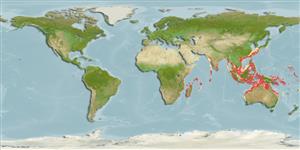Teleostei (teleosts) >
Dactylopteriformes (Flying gurnards) >
Dactylopteridae (Flying gurnards)
Etymology: Dactyloptena: Greek, daktylos = fingers + Greek, pten, -enos = wing, fin.
More on author: Bleeker.
Environment: milieu / climate zone / depth range / distribution range
Ecology
Marine; demersal; depth range 45 - 177 m (Ref. 27821). Deep-water
Indo-West Pacific: southern India and Sri Lanka to the Philippines, south to northern Australia and Papua New Guinea (Ref. 6192).
Size / Weight / Age
Maturity: Lm ? range ? - ? cm
Max length : 30.0 cm TL male/unsexed; (Ref. 48635)
Differ in color from the more common D. orientalis by the lack of blue lines in the pectoral fins and has a centrally placed dark blotch on the fin instead. Also the body lacks black spots (Ref. 48635).
Found in the continental shelf (Ref. 7300, 75154). Rarely observed due to mud-preferred habitats (Ref. 48635). Benthic (Ref. 75154). Not fished commercially but taken incidentally throughout its range. Usually caught near shore. Marketed fresh occasionally (Ref. 3392).
Life cycle and mating behavior
Maturity | Reproduction | Spawning | Eggs | Fecundity | Larvae
Eschmeyer, W.N., 1997. A new species of dactylopteridae (Pisces) from the Philippines and Australia, with a brief synopsis of the family. Bull. Mar. sci. 60(3):727-738. (Ref. 27821)
IUCN Red List Status (Ref. 130435: Version 2024-2)
Threat to humans
Harmless
Human uses
Fisheries: minor commercial; aquarium: commercial
Tools
Fatal error: Uncaught mysqli_sql_exception: Too many connections in /var/www/html/includes/speciessummary.lib.php:2004
Stack trace:
#0 /var/www/html/includes/speciessummary.lib.php(2004): mysqli->__construct()
#1 /var/www/html/summary/speciessummary.php(1812): checkRecordDisplayFBQuizV2()
#2 {main}
thrown in /var/www/html/includes/speciessummary.lib.php on line 2004
